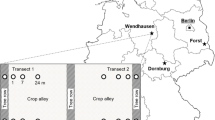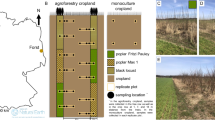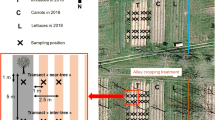Abstract
The benefits of tree-based intercropping (TBI) compared to conventional agro-ecosystems in North America could include climate change mitigation and adaptation, although enhancing resilience to climate change through increasing soil diversity remains poorly explored. Diversity of soil microarthropods supports a series of ecological services that may be altered by soil desiccation due to climate change. Here we study the effect of red oak and hybrid poplar TBI on soil oribatid mite species assemblages associated to forage crops (mix of Timothy-grass and red clover). Abundance and species density of oribatids were affected by treatment, depth and the interaction of both variables. Abundance of oribatid mites was significantly lower in the oak TBI, showing a homogeneous vertical distribution in opposition to a decreasing with depth distribution under poplar TBI and conventional crops. Species density was significantly higher in the conventional crop, showing again significant differences in depth that were not present in both TBI treatments. Distance to tree did not affect mite abundance nor species density. TBI increased oribatid richness (obtained by sample-based rarefaction and extrapolation) only in the presence of oaks. The distribution of oribatids was strongly associated to tree fine root biomass and stress the importance of underground organic resources for the oribatid fauna and their ecological functions. If increasing drought associated with climate change desiccates superficial levels of agro-ecosystem soils, deeper sources of organic resources, such as tree roots, should become crucial in the maintenance of diverse microarthropod communities.



Similar content being viewed by others
References
Agriculture Canada Expert Committee on Soil Survey (1987) The Canadian system of soil classification (CSSC), 2nd edn. Agriculture Canada, Ottawa
Badejo MA, Tian G (1999) Abundance of soil mites under four agroforestry tree species with contrasting litter quality. Biol Fertil Soils 30:107–112
Bainard LD, Klironomos JN, Gordon AM (2011) Arbuscular mycorrhizal fungi in tree-based intercropping systems: a review of their abundance and diversity. Pedobiologia 54:57–61
Bainard LD, Koch AM, Gordon AM, Klironomos JN (2012) Temporal and compositional differences of arbuscular mycorrhizal fungal communities in conventional monocropping and tree-based intercropping systems. Soil Biol Biochem 45:172–180
Bainard LD, Koch AM, Gordon AM, Klironomos JN (2013) Growth response of crops to soil microbial communities from conventional monocropping and tree-based intercropping systems. Plant Soil 363:345–356
Balogh J (1972) The oribatid genera of the world. Académiai Kiadó, Budapest
Bambrick AD, Whalen JK, Bradley RL, Cogliastro A, Gordon AM, Olivier A, Thevathasan NV (2010) Spatial heterogeneity of soil organic carbon in tree-based intercropping systems in Quebec and Ontario, Canada. Agrofor Syst 79:343–353
Bardgett RD, Anderson JM, Behan-Pelletier V, Brussaard L, Coleman DC, Ettema C, Moldenke A, Schimel JP, Wall DH (2001) The role of soil biodiversity in the transfer of materials between terrestrial and aquatic systems. Ecosystems 4:421–429
Behan-Pelletier VM (1999) Oribatid mite biodiversity in agroecosystems: role for bioindication. Agric Ecosyst Environ 74:411–423
Behan-Pelletier VM (2003) Acari and Collembola biodiversity in Canadian agricultural soils Can J. Soil Sci 83:279–288
Bergeron M, Lacombe S, Bradley RL, Whalen J, Cogliastro A, Jutras M-F, Arp P (2011) Reduced soil nutrient leaching following the establishment of tree-based intercropping systems in eastern Canada. Agroforest Syst 83:321–330
Blankinship JC, Niklaus PA, Hungate BA (2011) A meta-analysis of responses of soil biota to global change. Oecologia 165:553–565
Böhm W (1976) In situ estimation of root length at natural soil profiles. J Agric Sci 87:365–368
Bonsal BR, Wheaton EE, Chipanshi AC, Lin C, Sauchyn DJ, Wen L (2011) Drought research in Canada: a review. Atmos-Ocean 49:303–319
Bradford MA, Jones TH, Bardgett RD et al (2002) Impacts of soil faunal community composition on model grassland ecosystems. Science 298:615–618
Cardinael R, Thevathasan N, Gordon A, Clinch R, Mohammed I, Sidders D (2012) Growing woody biomass for bioenergy in a tree-based intercropping system in southern Ontario, Canada. Agrofor Syst 86:279–286
Colwell RK, Chao A, Gotelli NJ, Lin S-Y, Mao CX, Chazdon RL, Longino JT (2012) Models and estimators linking individual-based and sample-based rarefaction, extrapolation and comparison of assemblages. J Plant Ecol 5:3–21
Crossley DA, Mueller BR, Perdue JC (1992) Biodiversity of microarthropods in agricultural soils: relations to processes. Agric Ecosyst Environ 40:37–44
Development Core Team R (2010) A language and environment for statistical computing. Fundation for Statistical Computing, Vienna
Doblas-Miranda E, Sánchez-Piñero F, González-Megías A (2009) Vertical distribution of soil macrofauna in an arid ecosystem: are litter and belowground compartmentalized habitats? Pedobiologia 52:361–373
Eisenhauer N, Reich PB (2012) Above- and below-ground plant inputs both fuel soil food webs. Soil Biol Biochem 45:156–160
Eissfeller V, Langenbruch C, Jacob A, Maraun M, Scheu S (2013) Tree identity surpasses tree diversity in affecting the community structure of oribatid mites (Oribatida) of deciduous temperate forests. Soil Biol Biochem 63:154–162
Garrett CJ, Crossley DA Jr, Coleman DC, Hendrix PF, Kisselle KW, Potter RL (2001) Impact of the rhizosphere on soil microarthropods in agroecosystems on the Georgia piedmont. Appl Soil Ecol 16:141–148
Gulvik ME (2007) Mites (Acari) as indicators of soil biodiversity and land use monitoring: a review. Pol J Ecol 55:415–440
Hansen RA (2000) Effects of habitat complexity and composition on a diverse litter microarthropod. Ecology 81:1120–1132
Heneghan L, Bolger T (1998) Soil microarthropod contribution to forest ecosystem processes: the importance of observational scale. Plant Soil 205:113–124
IPCC, Intergovernmental Panel on Climate Change (2007) The physical science basis. Working group I contribution to the fourth assessment report of the IPCC. Cambridge University Press, Cambridge
Johnston JM, Crossley DA Jr (2002) Forest ecosystem recovery in the southeast US: soil ecology as an essential component of ecosystem management. For Ecol Manag 155:187–203
Krantz GW, Walter DE (2009) A manual of acarology, 3rd edn. Texas Tech University Press, Lubbock
Kuenen FJA, Venema H, Gestel CAM, Verhoef HA (2009) Extracting soil microarthropods with olive oil: a novel mechanical extraction method for mesofauna from sandy soils. Eur J Soil Biol 45:496–500
Lacombe S, Bradley RL, Hamel C, Beaulieu C (2009) Do tree-based intercropping systems increase the diversity and stability of soil microbial communities? Agric Ecosyst Environ 131:25–31
Lindberg N, Bengtsson J (2005) Population responses of oribatid mites and collembolans after drought. Appl Soil Ecol 28:163–174
Moldenke AR, Fichter BL (1988) Invertebrates of the H.J. Andrews Experimental Forest, western Cascade Mountains, Oregon: IV. The oribatid mites (Acari: Cryptostigmata). Gen. Tech. Rep. PNW-GTR-217. USDA-FS, Pacific NW Research Station, Portland
Moore JC, Walter DE, Hunt HW (1988) Arthropod regulation of micro- and mesobiota in below-ground detrital food webs. Annu Rev Entomol 33:419–439
Norton RA, Behan-Pelletier VM (2007) Eniochthonius mahunkai sp. n. (Acari: Oribatida: Enionchthoniidae), from north american peatlands, with a redescription of Eniochthonius and key to north american species. Acta Zool Acad Sci Hung 53:295–333
Osler GHR, Beattie AJ (1999) Taxonomic and structural similarities in soil oribatid communities. Ecography 22:567–574
Osler GHR, Harrison L, Kanashiro DK, Clapperton MJ (2008) Soil microarthropod assemblages under different arable crop rotations in Alberta, Canada. App Soil Ecol 38:71–78
Paoletti MG (1988) Soil invertebrates in cultivated and uncultivated soils in northeastern Italy. Redia 71:501–563
Pollierer MM, Langel R, Körner C, Maraun M, Scheu S (2007) The underestimated importance of belowground carbon input for forest soil animal food webs. Ecol Lett 10:729–736
Rivest D, Cogliastro A, Bradley RL, Olivier A (2010) Intercropping hybrid poplar with soybean increases soil microbial biomass, mineral N supply and tree growth. Agrofor Syst 80:33–40
Scharroba A, Dibbern D, Huenninghaus M, Kramer S, Moll J, Butenschoen O, Bonkowski M, Buscot F, Kandeler E, Koller R, Kruger D, Lueders T, Scheu S, Ruess L (2012) Effects of resource availability and quality on the structure of the micro-food web of an arable soil across depth. Soil Biol Biochem 50:1–11
Schoeneberger M, Bentrup G, de Gooijer H, Soolanayakanahally R, Sauer T, Brandle J, Zhou X, Current D (2012) Branching out: agroforestry as a climate change mitigation and adaptation tool for agriculture. J Soil Water Conserv 67:128–136
Seastedt TR (1984) The role of microarthropods in decomposition and mineralization processes. Annu Rev Entomol 29:25–46
Siepel H (1995) Applications of microarthropod life-history tactics in nature management and ecotoxicology. Biol Fertil Soils 19:75–83
Toor IA, Smith EG, Whalen JK (2012) Tree-based intercropping in southern Ontario, Canada. Can J Agric Econ 60:141–154
Whitford WG, Freckmann DW, Elkins NZ, Parker LW, Parmalee R, Phillips J, Tucker S (1981) Diurnal migration and response to stimulated rainfall in desert soil microarthropods and nematodes. Soil Biol Biochem 13:417–425
Witt C, Setala H (2010) Do plant species of different resource qualities form dissimilar energy channels below-ground? App Soil Ecol 44:270–278
Acknowledgments
This work benefitted from funds from the Fonds vert, part of the Plan d’action 2006–2012 sur les changements climatiques of the government of Québec. Lea Bouttier kindly provided her data on root biomass. We would like to thank Luana Graham-Sauvé for her help during the fieldwork and Émilie Rivest and Evick Mestre for their work during the extraction and identification of oribatids. EDM was partially supported by the BE-DGR 2011 program of the Catalonian Agency for Management of University and Research Grants, the MONTES-Consolider project (CSD2008-00040), funded by the Spanish Ministry of Economy and Competitiveness, and the NEWFORESTS project (612645), from the European 7FP.
Author information
Authors and Affiliations
Corresponding author
Rights and permissions
About this article
Cite this article
Doblas-Miranda, E., Paquette, A. & Work, T.T. Intercropping trees’ effect on soil oribatid diversity in agro-ecosystems. Agroforest Syst 88, 671–678 (2014). https://doi.org/10.1007/s10457-014-9680-y
Received:
Accepted:
Published:
Issue Date:
DOI: https://doi.org/10.1007/s10457-014-9680-y




